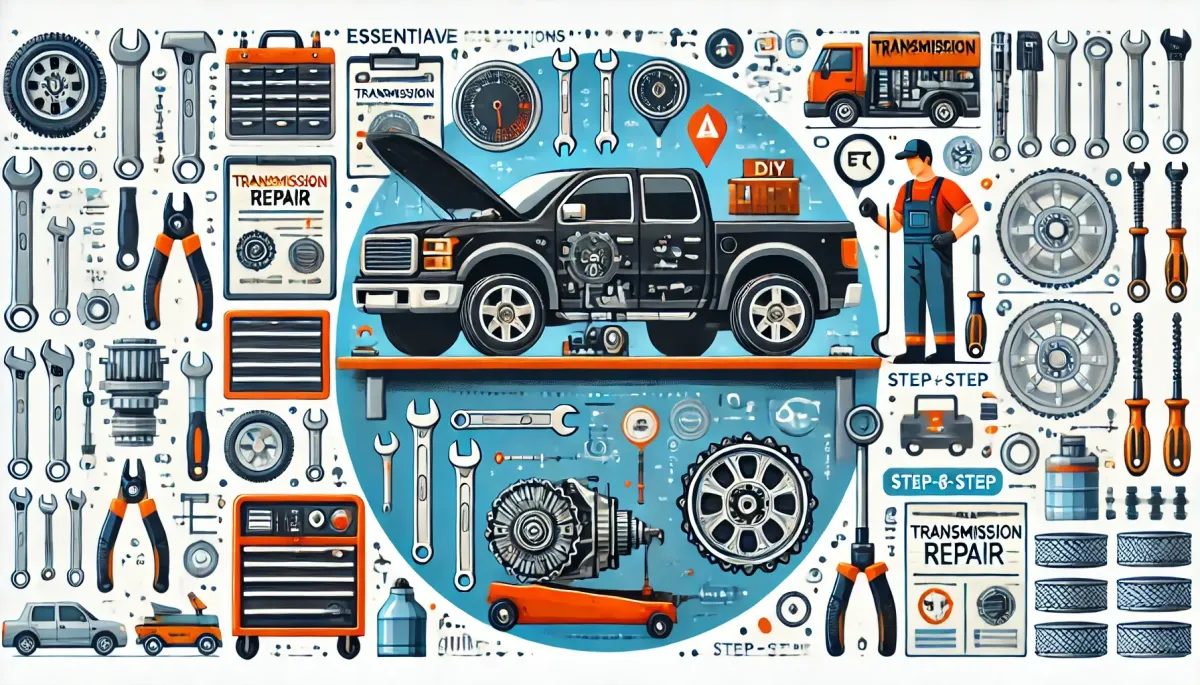
DIY Transmission Repairs: Tackling Common Pickup Truck Issues at Home
DIY Transmission Repairs: Tackling Common Pickup Truck Issues at Home
Transmission repairs can seem daunting, but with the right tools, knowledge, and a bit of confidence, many common issues can be fixed at home. Imagine saving time and money by handling repairs yourself and gaining a deeper understanding of your truck’s inner workings. In this chapter, we’ll guide you through DIY transmission repairs, from identifying issues to executing the fix, empowering you to keep your pickup truck running smoothly without always relying on a mechanic.
Key Points:
Preparing for DIY Repairs:
Essential Tools and Equipment
Safety Precautions and Best Practices
Understanding Your Transmission System
Identifying Common Transmission Issues:
Signs and Symptoms of Problems
Diagnostic Tools and Techniques
Prioritizing Repairs Based on Severity
Step-by-Step Repair Guides:
Fixing Transmission Fluid Leaks
Replacing Transmission Filters
Addressing Slipping Gears and Rough Shifting
Repairing or Replacing Solenoids
Testing and Verification:
Ensuring the Repair Was Successful
Road Testing Procedures
Monitoring Performance Post-Repair
Real-World Examples:
Preparing for DIY Repairs:
Steve invested in quality tools and created a dedicated workspace, making his repair process smoother and safer.
Anna learned the hard way about the importance of safety after an accident in her garage, emphasizing the need for proper precautions.
Identifying Issues:
Mike used a diagnostic scanner to identify a slipping gear issue, saving him from unnecessary repairs.
Lisa’s methodical approach to diagnosing a fluid leak helped her fix the problem quickly and efficiently.
Repair Guides:
Frank successfully fixed a fluid leak by replacing a damaged gasket, following a detailed guide.
Sarah replaced her truck’s transmission filter, improving performance and preventing future issues.
Testing and Verification:
John followed a thorough road testing procedure to ensure his DIY repair was effective.
Kelly monitored her truck’s performance after a solenoid replacement, catching a minor issue early.
In-Depth Analysis:
Preparing for DIY Repairs:
Essential Tools: Gather basic tools like wrenches, screwdrivers, a transmission jack, torque wrench, diagnostic scanner, and a fluid pump.
Safety Precautions: Always use proper lifting equipment, work in a well-ventilated area, and wear protective gear. Disconnect the battery before starting.
Understanding Your Transmission: Study your truck’s manual and learn about the transmission system, including common components and their functions.
Identifying Common Transmission Issues:
Signs and Symptoms: Look for fluid leaks, slipping gears, rough shifts, and unusual noises. Each symptom can indicate specific issues.
Diagnostic Tools: Use a diagnostic scanner to read transmission codes, and inspect fluid levels and quality regularly.
Prioritizing Repairs: Address critical issues like fluid leaks and slipping gears first, as they can lead to major damage if left unattended.
Step-by-Step Repair Guides:
Fixing Fluid Leaks:
Identify the source of the leak (e.g., gasket, seal).
Drain the transmission fluid.
Replace the damaged part (gasket, seal) and refill with new fluid.
Replacing Transmission Filters:
Locate the filter and drain the fluid.
Remove the old filter and replace it with a new one.
Refill with the recommended transmission fluid.
Addressing Slipping Gears and Rough Shifting:
Check fluid levels and quality; replace if necessary.
Inspect and replace worn or damaged solenoids.
Repairing or Replacing Solenoids:
Identify the faulty solenoid using a diagnostic scanner.
Remove the transmission pan to access the solenoid.
Replace the solenoid and reassemble the transmission.
Testing and Verification:
Ensuring Success: Double-check all connections and parts before testing.
Road Testing: Conduct a test drive, gradually increasing speed and observing for any issues.
Post-Repair Monitoring: Regularly check fluid levels and listen for any unusual noises, ensuring the repair holds over time.
Practical Applications:
Step-by-Step Repair Guide:
Fluid Leak Repair: Identify, drain fluid, replace damaged gasket/seal, refill fluid.
Filter Replacement: Drain fluid, replace filter, refill fluid.
Solenoid Replacement: Diagnose, access solenoid, replace, reassemble.
Tool Recommendations:
Transmission Jack: For safe lifting and handling during repairs.
Torque Wrench: Ensures bolts are tightened to the correct specifications.
Diagnostic Scanner: Essential for identifying and diagnosing transmission issues.
Tips and Tricks:
Document the Process: Take photos and notes during disassembly to aid reassembly.
Keep Clean: Prevent dirt and debris from entering the transmission system during repairs.
Consult Forums: Online communities can provide valuable advice and troubleshooting tips.
Conclusion:
DIY transmission repairs can be a rewarding way to maintain your pickup truck while saving money. By preparing adequately, diagnosing issues accurately, and following step-by-step guides, you can tackle common transmission problems with confidence. Regular testing and monitoring post-repair will ensure your efforts lead to lasting improvements.
Call to Action:
Ready to roll up your sleeves and start your DIY transmission repair? Share your repair stories and tips in the comments below, and let’s build a community of knowledgeable and empowered truck owners. Your experience could inspire and help others on their DIY journey!
Ready to experience the TTS difference?
Visit prebuilttrans.com to learn more about our services or to schedule an appointment or call +1 385-462-8458 for more info! We're dedicated to keeping your pick-up truck running in tip-top shape!
Disclaimer: This blog post is intended for informational purposes only and should not be interpreted as professional advice. Always consult with a qualified mechanic or transmission specialist for specific recommendations regarding your vehicle.
© 2024 Truck Transmission Specialists. All rights reserved.
Get In Touch
FAQS
How quickly can I expect to have My truck back on the road?
At TTS, we prioritize fast and efficient repairs because we understand that downtime means lost business. With our comprehensive inventory of parts, there’s no waiting for shipments or delays from lengthy rebuilds. You can order the needed parts from our online shop, set a date, and we’ll ensure your truck is back on the road promptly. No fuss, no backorders, just efficient service to keep your wheels turning.
What types of vehicles do you provide transmission service for?
We specialize in prebuilt transmissions for domestic U.S. trucks, focusing primarily on Dodge, Ford, Chevy, and GMC brands. Our inventory ensures quick availability and installation, minimizing downtime for your vehicle. If you have any questions or need further assistance, feel free to chat with us online or give us a call. We’re here to help you get back on the road swiftly and efficiently.
Is roadside assistance or towing available?
Yes, we offer free towing for vehicles within a 50-mile radius of our Orem location and special rates for longer distances. If you need assistance after hours, please leave a message, text us, or use our site chat bot to provide your contact information. Someone will reach out to you as quickly as possible to arrange pick-up. Feel free to call us for any additional information or assistance.
What types of services does TTS Emergency Road Service offer?
TTS Emergency Road Service provides a wide range of services to ensure you are covered for any situation. Our offerings include:
Transmission Replacement
Transmission Upgrades
Transmission Repair
Towing services
Fleet maintenance inspections
Each service is designed to get you back on the road as quickly and safely as possible. Whether you have a transmission down or need a comprehensive inspection for your fleet, we've got you covered.


